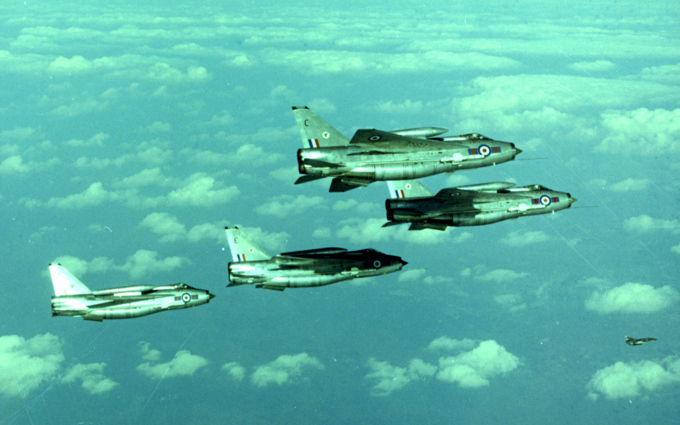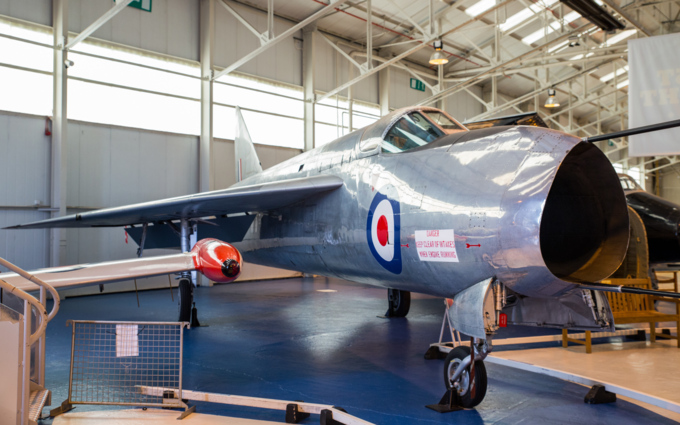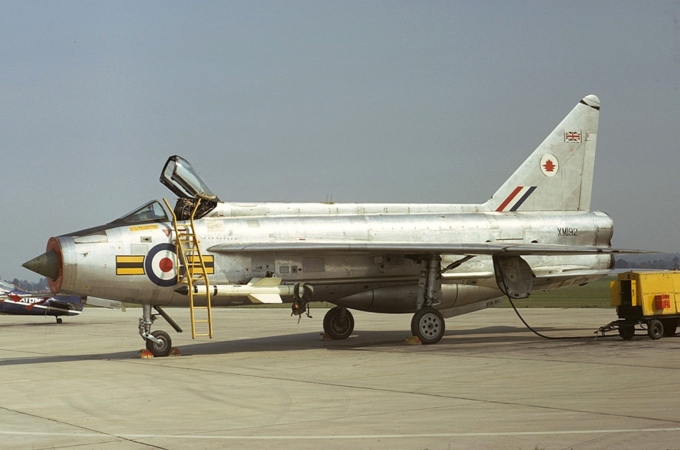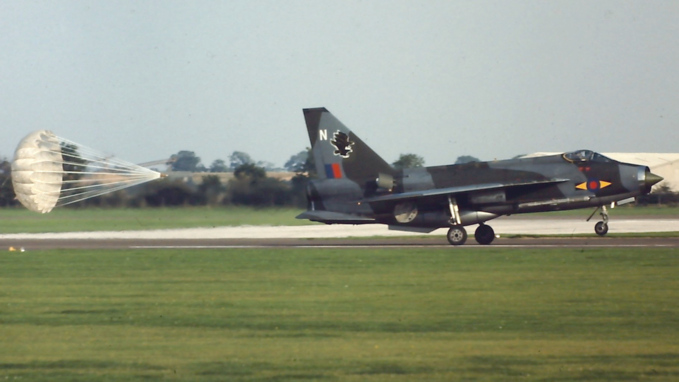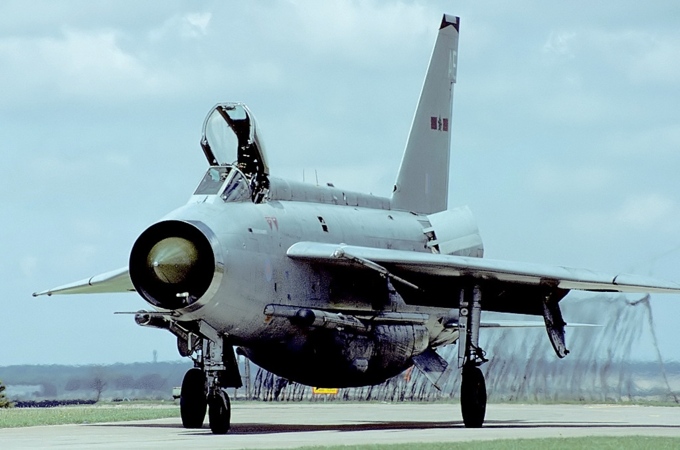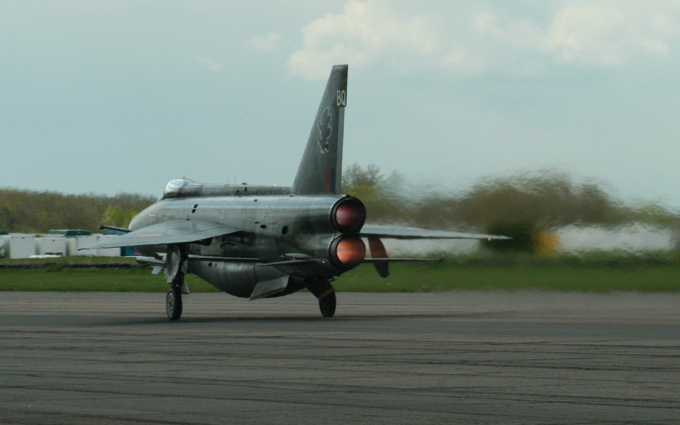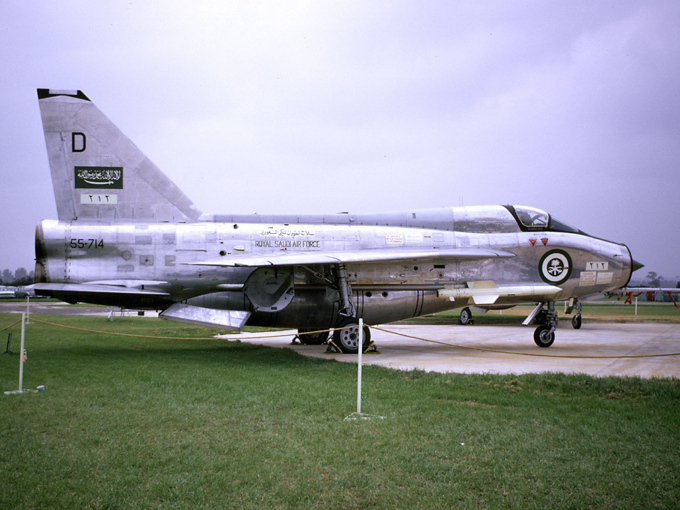The English Electric Lightning was the RAF’s primary front-line interceptor from its introduction in 1959 up until the mid-1970s when it began to be replaced by the Phantom FGR.2. Even so, the Lightning would continue to serve in the interceptor role with the RAF until 1988, leaving RAF service less than two years before the first Phantoms began to be retired from service. Although the Lightning was primarily used to intercept Soviet bombers entering UK airspace, it was also stationed outside the UK, most notably in Germany; the Lightning also saw service at RAF Tengah in Singapore and RAF Akrotiri in Cyprus. Despite serving in the RAF for 29 years, the Lightning never once shot down a hostile aircraft. Officially, the only aircraft ever shot down by a Lightning was a pilotless Harrier; the pilot had ejected, however the Harrier kept flying. It was decided to shoot it down rather than risk it entering Soviet territory.
Background
In February 1946, the British government cancelled the Miles M.52 programme, only a few months before the first prototype was due to fly. The M.52 was a supersonic research aircraft, designed to reach speeds in excess of 1,000 mph (1,600 km/h) and potentially become the first aircraft to achieve supersonic speeds in level flight. The cancellation sent a message to the aviation industry that the British Government had little interest in the development of supersonic aircraft. This did not deter English Electric Company engineer W. E. W. Petter; from his work designing the Canberra bomber, he could tell that current fighters would be incapable of intercepting such an aircraft, and so began sketching designs for a new supersonic fighter.
Petter lobbied the government to pursue supersonic aircraft development and in early 1947 presented his proposed design to the Ministry of Supply (MoS). To his surprise, this led to the MoS issuing specification ER.103 calling for companies to produce designs for a supersonic research aircraft capable of Mach 1.5 at 36,000 ft. English Electric set to work on their proposal, which would later be known as the P.1.
Development
By mid-1948, most of the P.1's key design features were in place: the aircraft would have two engines stacked one on top of the other (this allowed for a 2x increase in thrust while only increasing frontal area by 1.5x) and highly swept wings. English Electric was given a contract to develop the design further through 1949; wind tunnel testing indicated that the tailplane should be moved from the top of the vertical stabiliser (like the Javelin) to the bottom of the fuselage, and the wing sweep increased from 40° to 60°. By the end of 1949, most of the P.1's design had been finalised.
In September 1949, the MoS released the first draft of specification F.23/49 laying out the requirements for a supersonic fighter aircraft. English Electric decided they could modify the P.1 design to meet the new F.23/49 specification. In April 1950, they received a contract to produce three prototype P.1 aircraft (two for flight testing and one for static testing).
Engineers at the Royal Aircraft Establishment (RAE) doubted English Electric’s design for the P.1, believing that the aircraft should have had a 50° swept wing and kept the original high-mounted tailplane; this would lead to a second contract being handed to Short Brothers to produce an aircraft known as the SB.5. The SB.5 was a low-speed research aircraft (resembling the P.1) which facilitated the wings and tail being mounted in different configurations, with the aim being to find out whether English Electric or the RAE were correct. Later testing would find that 60° was the optimal wing sweep and the high tail design would prove to be unstable in flight, proving English Electric correct in their design choices.
In July 1952, while English Electric was working on building the P.1 prototypes, they were notified that the government intended to order a number of prototype fighters built to the F.23/49 specification, and so detailed design on the modified P.1 began. To avoid confusion, the two original P.1 aircraft would be known as P.1 and P.1A with the new fighter version known as the P.1B. The official order for 3 P.1B prototypes was placed in August 1953 and was followed in February 1954 by an order for 20 P.1B development aircraft.
The P.1/P.1A were visually similar to the Lightning but had distinct differences; most notable were its use of non-afterburning Armstrong Siddeley Sapphire SA.5 engines and a significantly different cockpit and forward fuselage. The P.1 lacked the Lightning’s distinctive shock cone intake, instead having a pear-shaped intake in the nose and also initially lacked the ventral fuel tank of production Lightnings. The P.1B was much closer to the production Lightning F.1 aircraft, being visually very similar, and incorporating most of the features of the production aircraft.
The first P.1 was finished in May 1954 and taken to Boscombe Down, where it spent the next couple of months carrying out ground tests and fast taxi runs. With tests progressing well, the first flight for the P.1 was set to be 3rd August 1954. However, as test pilot Roland Beamont climbed into the cockpit for the first flight, he accidentally triggered the engine bay fire extinguishers; with the rest of the day spent cleaning up the fire retardant, the flight had to be postponed until the next day. The P.1 first flew on 4th August 1954, and shortly afterwards on its third flight it went supersonic, supercruising at Mach 1.02. In subsequent flights, supercruise at Mach 1.08 in level flight would be achieved, and in one flight the aircraft would eventually reach a speed of Mach 1.22.
The second P.1 prototype, known as P.1A, flew on 18th July 1955, featuring a ventral tank, twin 30 mm ADEN cannons mounted above the intake, and redesigned flaps. While the P.1A was undergoing testing, the original P.1 prototype was modified with Sapphire SA.5R engines which produced less dry thrust than the SA.5 but featured reheat (afterburner) which gave them much greater thrust than the SA.5 when engaged. With the new engines, the P.1 could reach Mach 1.56; the P.1A was never fitted with the new engines.
During testing of the P.1, problems with the cockpit canopy became apparent. On one test flight in August 1955, while the aircraft was flying at Mach 0.95, the canopy broke away from the aircraft. The test pilot was able to land without further incident, and the canopy locking mechanism was adjusted; however a few weeks later the canopy broke loose again. After further modifications English Electric believed the problem was resolved; until once more the canopy came away from the aircraft, this time while the aircraft was flying at supersonic speed. Following this incident, English Electric decided to completely redesign the canopy locking mechanism, finally fixing the issue. Luckily none of the pilots were seriously injured in any of the incidents.
The P.1B first flew on 4th April 1957 and was successfully taken to Mach 1.2 on its first flight. On the same day the P.1B first flew, the Government published the now infamous 1957 Defence White Paper, which cancelled most of Britain’s advanced aircraft programmes under the (now known to be incorrect) belief that missile technology would make manned aircraft irrelevant; the P.1 was one of the few aircraft programmes not cancelled.
On 23rd October 1958, the P.1B was officially renamed to the Lightning. Development of the P.1B continued with no major problems and on 25th November 1958 the P.1B became the first British aircraft to achieve Mach 2, sustaining it in level flight and with engines on the lowest of their four reheat settings. Development continued with the last of the 20 P.1B pre-production aircraft taking to the air in September 1959; this was followed by the first P.1B Lightnings being delivered to RAF service in December 1959.
RAF Service
The first production version of the Lightning to enter RAF service was the Lightning F.1, which differed only slightly from the pre-production P.1Bs. It entered service with 74 Squadron at Coltishall in 1960.
The F.1 was powered by two Avon 200R engines each producing 11,200 lb of dry thrust or 14,400 lb of thrust with maximum reheat (afterburner). In terms of armament, the F.1 had two 30 mm ADEN cannons mounted above the air intake and provision for three different interchangeable weapon packs to be fitted in the weapons bay. The most common weapons pack was the Firestreak pack; the internals of the pack contained electronic and cooling systems, while pylons protruding from either side of the pack allowed the Lightning to carry two Firestreak air-to-air missiles, one on either side of the fuselage. The other two packs were less well-known, one allowed the fitment of two additional 30 mm ADEN cannons (bringing the total to four), and the other allowed the carriage of a cartridge of 48 x 2” unguided air-to-air rockets. During normal flight the rockets would be stored internally, when the rockets were to be fired two launchers (each containing 24 rockets) would fold outwards from the weapon pack.
A total of 22 production standard Lightning F.1s were built before production was switched to the improved F.1A standard. The F.1A was only slightly different to the F.1, featuring provision for an in-flight refuelling probe, some re-routed cabling from inside the engine bay to external cable ducts on the side of the fuselage, and Avon 210R engines; the engines had modifications to the reheat control system, but performed the same as the Avon 200R engines of the F.1. The F.1A entered service in December 1960 serving alongside the Lightning F.1s. The first two-seat Lightning trainers, known as T.4s, were also delivered in 1960; the T.4 was based on the F.1A and featured two pilots sat side by side in the cockpit. By 1965, the F.1s and F.1As had been withdrawn from front-line service, joining the T.4s in being used for pilot training and other duties into the 1970s.
The next version of the Lightning to enter service was the F.2, planned as an interim version to enter service while the more advanced F.3 was still being developed. Externally it looked almost identical to the F.1A, with the only difference being the addition of a small air scoop on the “spine” of the aircraft. Internally however there were more changes; the engines were upgraded with fully variable reheat (instead of the 4 position reheat on earlier models), a significantly lighter and more compact oxygen system for the pilot, and an improved navigation system. The F.2 entered service with two squadrons in 1961, and became the first Lightning variant to serve outside the UK, being based at RAF bases in West Germany.
After the Lightning F.2 came the Lightning F.3, which was a major upgrade over all previous models of the Lightning. The most obvious external feature of the F.3 was a new, larger, squared-off tail; this was necessary to allow the F.3 to safely carry the new Red Top missile. The Red Top was a major improvement over the Firestreak, having improved range, a more destructive warhead, and a new seeker giving the missile limited all-aspect capability. Internally, the F.3 featured a more advanced AI.23B radar, new navigation equipment, and most significantly new Avon 301R engines. The Avon 301s produced significantly more thrust than previous Avon engines with 12,600 lb of dry thrust and 16,300 lb of thrust each on full reheat. The Lightning F.3 entered RAF service in January 1964.
Image credit: MilborneOne (Wikimedia) / CC BY-SA 3.0
The F.3 was followed into service by the F.3A and the T.5 (a two-seat trainer variant of the F.3) in 1965. The F.3A was an interim version designed to address the Lightning’s limited range before the planned F.6 version was ready. The F.3A significantly increased the size of the ventral fuel tank, in addition it was fitted with a new wing featuring a kinked and cambered leading edge; this wing reduced subsonic drag leading to a 20% increase in cruising range. The new wing also improved the handling characteristics of the Lightning; it did however come at the cost of reducing supersonic acceleration.
The final production model of Lightning to enter RAF service was the F.6. The Lightning F.6 had been intended to fix some of the shortfalls of the F.3; it included the enlarged ventral tank and new wing design of the F.3A, and returned the cannon armament with two 30 mm ADEN cannons mounted in the front of the ventral fuel tank. The F.6 also included support for a pair of over-wing fuel tanks, further improving the aircraft’s range. The F.6 entered service in December 1965, serving alongside the F.3s; the superior range of the F.6 led to them being used for long-range interception missions, while the higher performance F.3 lent itself to being used for shorter range missions. Although originally retaining the Avon 301 engines of the F.3 and F.3A, the F.6 would later be upgraded with Avon 302 engines; these engines provided better high altitude flight performance and reduced fuel consumption.
Image credit: Mike Freer (airliners.net) / GFDL 1.2
The improved range of the Lightning F.6 proved popular with the RAF and so it was decided to rebuild 31 of the Lightning F.2s stationed in Germany to near F.6 standard. These aircraft were known as F.2As and began entering service in 1968. They featured the enlarged ventral tank and new wings of the F.6, but retained the less powerful Avon 211 engines as well as the 30 mm cannons mounted in their original location above the intake. As the F.2A also lacked the updated avionics of later models, it was incapable of carrying Red Top missiles, instead carrying either Firestreaks or a gun pack containing two additional ADEN cannons. The F.2A was well-liked by its pilots, the fitment of ADEN cannons above the intake allowed the entire ventral tank to be filled with fuel (instead of partly being taken up by cannons); coupled with less fuel-hungry engines this gave it the best endurance of any Lightning variant. The F.2A spent most of its service life carrying out low-level interceptions missions in Germany, where the increased endurance was greatly appreciated.
With the Lightning F.6 being the ultimate version of the Lightning in RAF service, some may find it surprising to hear that it lagged behind most other Lightning models in terms of raw flight performance. The F.6 sacrificed the raw performance of previous Lightnings in order to improve the aircraft’s range and return the cannon armament. As an example, a Lightning F.1 could accelerate from stationary to 450 kts (833 km/h) within 36 seconds of brake release; while an F.6 would take 42 seconds to achieve the same. Likewise, from brake release to 36,000 ft would take 2 minutes 18 seconds in a Lightning F.1; while a Lightning F.6 would take 2 minutes 42 seconds. By far the best performing Lightning variant was the F.3; it mated the much more powerful engines of the F.6 with the significantly lighter airframe of earlier Lightnings.
Export Service
As well as RAF service, the Lightning did also see some export service with the Kuwait Air Force and Royal Saudi Air Force. The first Lightnings delivered to the Royal Saudi Air Force arrived in 1966; they came in the form of five Lightning F.52s and two T.54s. These aircraft were simply ex-RAF Lightning F.2s and T.4s. Through 1968–1969, both the Kuwait Air Force and the Royal Saudi Air Force took delivery of more advanced Lightning F.53s and T.55s.
The Lightning F.53 was effectively a Lightning F.6 upgraded to become a multi-role fighter. The most notable change was the addition of underwing hardpoints capable of carrying 1,000 lb bombs and SNEB rocket pods. In addition, the 2” rocket pack from the Lightning F.1 was returned to carry air-to-air or air-to-ground rockets, and a new photo-reconnaissance pack was made available, in addition to the Firestreak and Red Top weapon packs. Various improvements were proposed for the F.53 including adapters to allow two bombs or rocket pods to be fitted to each underwing pylon, and dual rocket pods to be carried on the over-wing pylons (originally used for the fuel tanks on the F.6). While the dual underwing adapter would be approved for use on Saudi Lightnings, the over-wing rocket pods never made it past mock-up stage. The T.55 was a T.5 upgraded to better reflect the Lightning F.53; it received the enlarged ventral tank and new wings of the Lightning F.6 and F.53.
Image credit: Steve Williams (airliners.net) / CC BY-SA 4.0
Bibliography
- Bowman, M. (2009). Lightning Strikes Twice: The Story of the English Electric Lightning. Stroud: Amberley Publishing.
- Burke, D. (2016). English Electric Lightning. Retrieved from Thunder and Lightnings
- Chorlton, M. (2012). The Lightning story — from P.1 to F.6. Aeroplane Icons, pp. 6-16.
- Darling, K. (2008). English Electric / British Aircraft Corporation Lightning Mks 1-6. Lulu.com.
- Derry, M. (2016). English Electric Lightning. Barnsley: Pen and Sword Aviation.
- Lightning F Mk 2A, Aircrew Manual. (1968). Warton Aerodrome, UK: English Electric Technical Services.
- Lightning F Mk. 53, Pilots Notes. (1983). Warton Aerodrome, UK: British Aircraft Corporation Ltd.
- Lightning F.Mk 6, Operating Data Manual. (1977). Warton Aerodrome, UK: English Electric Technical Services.
- Lightning F.Mks 1,1A, 2 & T.MK.4, Operating Data Manual. (1975). Warton Aerodrome, UK: English Electric Technical Services.
- Pike, R. (2011). The Lightning Boys. London: Grub Street.
- Pilot’s Notes, Lightning F.Mk 1 & F.Mk 1A. (1962). Warton Aerodrome, UK: English Electric Technical Services.
- Ransom, S., & Fairclough, R. (1987). English Electric Aircraft and their Predecessors. London: Putnam.
- Roux, E. (2007). Turbofan and Turbojet Engines Database Handbook. Lulu.com.
